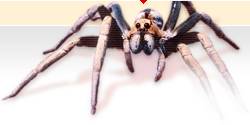
Mites
Order Prostigmata
(by Bruce Halliday)
The order Trombidiformes, also known as Prostigmata, is the most diverse of the major mite groups, in terms of the number of species it contains, and in the range of morphological and behavioural variation they display. They are called Prostigmata because the stigmata are usually located at the base of the mouthparts, or on the anterior margin of the opisthosoma. The cohort Eupodina includes the family Penthalaeidae, in which the redlegged earth mite Halotydeus destructor and blue oat mite Penthleus major are serious pests of crops and pastures in southern Australia. The same cohort also includes the predatory families Bdellidae and Cunaxidae, whose members have been used as biological control agents of mite pests in pastures and horticulture (Gerson et al. 2003).
The superfamily Eriophyoidea includes thousands of species of plant parasites, many of which are important crop pests, either through the damage they cause directly, or through their role as vectors of plant viruses. The cohort Anystina includes beneficial predatory species among its 6 families. The cohort Parasitengona includes hundreds of species, most of which have a complex life cycle in which the larval stage is a parasite and later stages are free-living predators. Larval Trombiculidae are parasites of vertebrates, commonly known as chiggers, the Australian fauna of which has been catalogued by Domrow and Lester (1985). Several families including Erythraeidae and Trombidiidae have larvae that are parasitic on insects, and terrestrial adults that are often called red velvet mites. Only a handful of species have been reared in captivity to allow the adults and larvae to be correlated.
A further group of families is collectively known as "water mites" or Hydracarina. The larvae of these groups are mostly parasites of aquatic insects, and the adults are often large brightly coloured mites that can be found swimming in fresh water. Harvey (1998) reviewed the Australian fauna, which includes over 400 known species spread over 24 families.
A further important group of Prostigmata includes the spider mites of the family Tetranychidae. These are damaging pests of crop plants, especially in horticulture, but the Australian fauna has never been systematically studied. The cohort Heterostigmata includes about 12 families of small to minute mites, many of which have close associations with insects. The existence of intra-species polymorphism and often bizarre morphologies has meant that the taxonomy of these groups is very unstable, even at the family level. A diverse range of families of Prostigmata that are parasites of vertebrates have been catalogued by Domrow (1991).
References
Domrow R. 1991. Acari Prostigmata (excluding Trombiculidae) parasitic on Australian vertebrates: an annotated checklist, keys and bibliography. Invertebrate Taxonomy 4, 1238-1376.
Gerson U., Smiley R.L. & Ochoa R. 2003. Mites (Acari) for Pest Control. Blackwell, Oxford, 539 pp.

